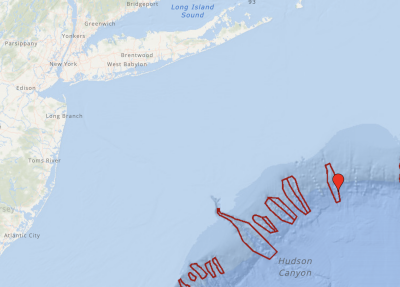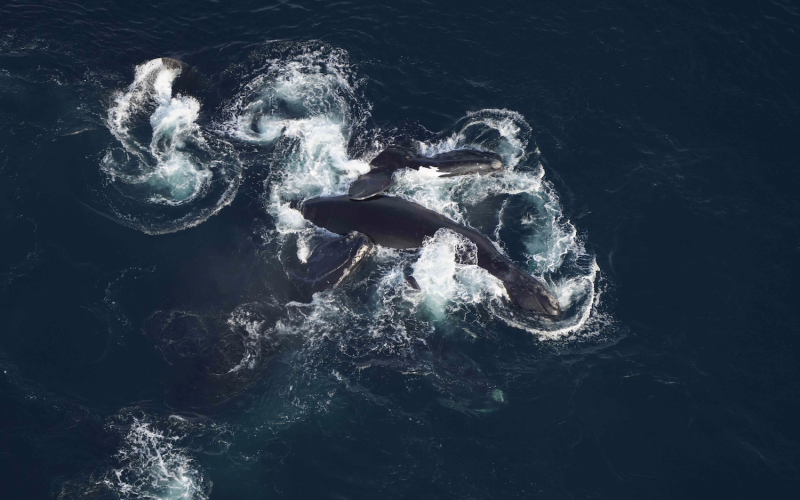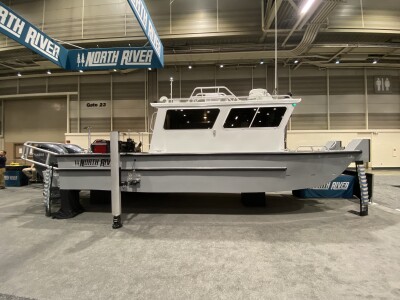Scientists this summer tracked a concentration of North Atlantic right whales – more than one-quarter of the highly endangered population – 40 to 70 miles south of Long Island, N.Y., an unusual feeding area for the mammals and waters heavily trafficked by shipping and fishing vessels.
Researchers with the New England Aquarium’s Anderson Cabot Center for Ocean Life spotted over 82 North Atlantic right whales, including 56 in one day, during aerial surveys in late July and into August, according to a statement from the aquarium.
The National Marine Fisheries Service estimates the entire North Atlantic right whale population numbers only around 360 animals, so the unusual grouping represented more than 25 percent of the species.
“This Mid-Atlantic aggregation is a good reminder that the movement patterns of North Atlantic right whales are always responding and adapting to changing ocean conditions,” said Katherine McKenna, an Anderson Cabot Center research scientist who was aboard several of the five aerial survey flights. “This multi-month grouping of whales south of Long Island is very unusual.”
Whale researchers say right whales have redistributed their movements in U.S. and Canadian waters in response to environmental changes and resulting movements of the prey the whales feed on.
Aerial teams spotted the whales were seen in the Hudson and Block Canyon areas along with abundant fin and humpback whales, dolphins, manta rays, whale sharks, tuna, and sea turtles.

“Typically, whales congregate in areas where they can feed efficiently. North Atlantic right whales have likely been feeding in that area for months now, and their presence near the canyons could indicate plentiful food,” according to the aquarium. “The scientists observed the whales spending up to 10 minutes under the surface before re-emerging in the same areas and occasionally defecating – both behaviors indicate feeding.”
An aerial survey team with NMFS’ Northeast Fisheries Science Center first documented the whale aggregation at the end of May, continuing to track the animals leading up to the Anderson Cabot Center team’s sightings. “The sightings and aerial surveys by the Aquarium team have been critical to helping understand the right whales’ use of the region,” said Tim Cole, a research fisheries biologist with NEFSC.
The dire situation of North Atlantic right whales has led NMFS to impose vessel speed limits in approaches to East Coast ports when whales are sighted in those areas. Vessel strikes and fishing gear entanglements are leading causes of injury and death to right whales and other species in U.S. waters, according to NMFS and whale researchers.
Groups opposed to offshore wind energy development are focused on potential harm to right whales from disrupting their feeding and movements during construction and operation of wind turbine arrays. Projects already in place off southern New England, and planned south to the Carolinas and eventually even the deepwater Gulf of Maine, are along the right whales’ historic pathways.
In its summary of the whale sightings, the New England Aquarium made a pitch for proposed new speed restrictions on vessels.
“Currently, no mandatory speed restrictions, which are known to reduce the risk of lethal vessel strikes to large whales, exist where these aggregations have been sighted. The proximity of such a large proportion of the population to a busy marine traffic area for so long raises concern about the risk of vessel strikes to these whales. Several were seen with propeller wounds, which serves as a reminder that it is important for mariners to be on the lookout for whales, even when mariners are not traveling in mandatory slow zones.”
NMFS is still considering modifications to the existing vessel speed rule to protect North right whales, first proposed in August 2022. Those proposed changes could expand areas with seasonal speed restrictions and keep them in effect longer.
One major change would impose speed restrictions on smaller vessels 35 to 65 feet in length. That proposal raises bitter opposition from the charter fishing industry, recreational boat builders, harbor pilot associations and others who say it will endanger mariners’ safety in bad weather and sea conditions. Their allies in Congress are working to block the changes.





